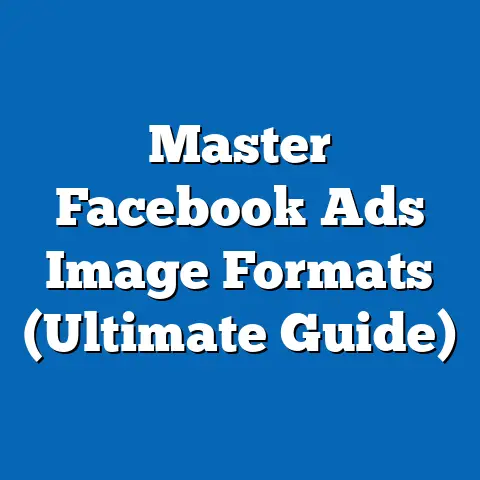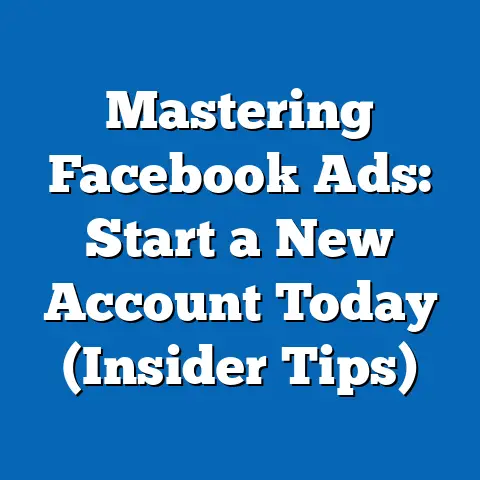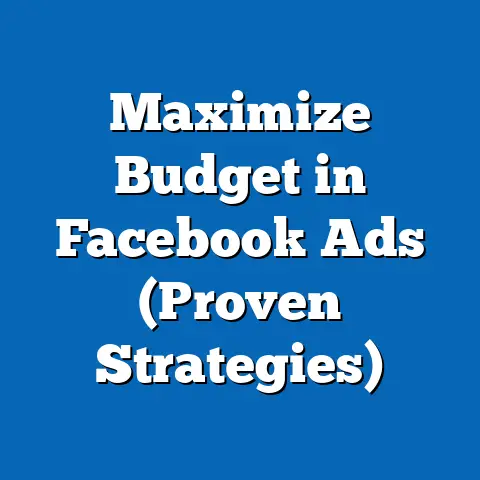Craft Captivating Real Estate Facebook Ads (Proven Strategies)
Imagine this: You’re a realtor, phone buzzing non-stop, juggling showings, paperwork, and client calls. You’re exhausted, but you know you need to reach more potential buyers and sellers. Then it hits you: Facebook! But throwing up a blurry photo of a house and hoping for the best isn’t going to cut it. In the fast-paced world of real estate, where every moment counts, your next client could be scrolling through Facebook right now. Are your ads captivating enough to stop them in their tracks?
Facebook, with its billions of users, is an absolute goldmine for real estate professionals. It offers unparalleled reach and laser-sharp targeting capabilities, allowing you to connect with the exact people who are most likely to buy or sell a home in your area. But here’s the kicker: simply being on Facebook isn’t enough. You need to craft captivating ads that grab attention, spark interest, and drive action.
Think about Sarah, a realtor in Austin, Texas. She was struggling to generate leads until she completely revamped her Facebook ad strategy. By focusing on high-quality visuals, hyper-local targeting, and compelling copy, she saw a 300% increase in leads in just one month! Her secret? She understood the power of a well-crafted Facebook ad.
Key Takeaway: Facebook is a powerful platform for real estate marketing, but success requires a strategic approach focused on creating captivating ads that resonate with your target audience.
Section 1: Understanding Your Audience
Knowing your audience is paramount. It’s the foundation upon which all successful marketing campaigns are built, and it’s especially crucial in the competitive world of real estate. You can have the most beautifully designed ad with the most persuasive copy, but if you’re showing it to the wrong people, it’s like shouting into the void.
Think about it: a young couple looking for their first starter home has different needs and priorities than a wealthy retiree looking for a luxury beachfront property. Trying to reach both with the same generic ad is a recipe for disaster.
Demographic Factors: More Than Just Age and Location
When defining your target audience, go beyond the basics of age and location. Consider these crucial demographic factors:
- Age: Are you targeting millennials, Gen Xers, or Baby Boomers? Each generation has different communication preferences and priorities.
- Income: What’s the average income of your ideal client? This will help you determine the price range of properties to feature in your ads.
- Location: Are you focused on a specific city, neighborhood, or zip code? Hyper-local targeting is incredibly effective in real estate.
- Lifestyle: What are their hobbies, interests, and values? Are they outdoorsy, family-oriented, or luxury-focused?
- Life Stage: Are they first-time homebuyers, growing families, empty nesters, or retirees?
Leveraging Facebook Audience Insights: Your Secret Weapon
Facebook Audience Insights is a free tool that provides a wealth of data about your target audience. It allows you to explore demographics, interests, behaviors, and more. I’ve personally used this tool to uncover hidden interests and refine my targeting, leading to significantly better results.
Here’s how to use it:
- Go to Facebook Audience Insights: You can find it in the Ads Manager under “Tools.”
- Choose Your Audience: You can either start with everyone on Facebook or connect it to your existing Facebook page.
- Define Your Interests: Start by entering broad interests related to real estate, such as “real estate investing,” “home buying,” or specific neighborhoods in your area.
- Explore the Data: The tool will provide insights into demographics, page likes, location, activity, household income, and purchase behavior.
Tailored Messaging: Speaking Directly to Your Ideal Client
Once you have a clear understanding of your target audience, you can craft tailored messaging that resonates with their specific needs and desires.
Here are a few examples:
- First-Time Homebuyers: Focus on affordability, starter homes, and the excitement of owning their first property. Use language like “Stop Renting, Start Owning!” and highlight programs for first-time buyers.
- Luxury Real Estate Investors: Emphasize exclusivity, high-end amenities, and investment potential. Use sophisticated language and showcase properties with stunning visuals.
- Renters Transitioning to Buyers: Address their concerns about down payments, mortgages, and the responsibilities of homeownership. Offer resources and guides to help them navigate the process.
Example: I once ran a campaign targeting young professionals in a specific neighborhood known for its trendy restaurants and nightlife. Instead of just showing houses, I highlighted the neighborhood’s walkability, proximity to amenities, and vibrant social scene. The result? A flood of inquiries from my target audience.
Key Takeaway: Understanding your target audience is crucial for creating effective Facebook ads. Use Facebook Audience Insights to gather data and tailor your messaging to resonate with their specific needs and desires.
Section 2: Crafting Compelling Copy
The words you use in your Facebook ads are just as important as the visuals. Compelling copy is what grabs attention, sparks interest, and ultimately, drives action. It’s the art of persuasion in a few carefully chosen words.
The Elements of Persuasive Ad Copy
Let’s break down the key elements of effective ad copy:
- Headline: This is the first thing people see, so it needs to be attention-grabbing and relevant. Use strong verbs, numbers, and question marks to pique curiosity.
- Body Text: This is where you provide more details about the property or service you’re offering. Focus on the benefits, not just the features.
- Call-to-Action (CTA): This tells people what you want them to do next. Use clear and concise language like “Learn More,” “Schedule a Showing,” or “Get a Free Consultation.”
The Psychology Behind Effective Copywriting
Effective copywriting isn’t just about writing pretty words; it’s about understanding the psychology of your target audience.
- Emotional Triggers: Tap into their emotions by highlighting the benefits of homeownership, such as security, pride, and financial stability.
- Storytelling: Share stories of happy clients who found their dream home with your help. People connect with stories on a deeper level.
- Urgency: Create a sense of urgency by highlighting limited-time offers, low inventory, or upcoming deadlines.
High-Performing Ad Copy Examples (and Why They Work)
Let’s analyze a few examples of high-performing ad copy in the real estate niche:
-
Example 1 (First-Time Homebuyers):
- Headline: Stop Renting, Start Owning!
- Body Text: Tired of throwing money away on rent? Discover affordable homes in [City Name] with low down payment options. Get pre-approved today!
- CTA: Learn More
- Why it works: It addresses the pain points of renters and offers a solution. The headline is attention-grabbing, and the body text highlights the benefits of homeownership.
-
Example 2 (Luxury Real Estate):
-
Headline: Experience Unparalleled Luxury in [Neighborhood Name]
- Body Text: Discover exquisite estates with breathtaking views, private pools, and state-of-the-art amenities. Schedule a private showing today.
- CTA: Schedule a Showing
- Why it works: It appeals to the desire for exclusivity and luxury. The language is sophisticated, and the visuals are stunning.
-
Example 3 (Relocation):
-
Headline: Moving to [City Name]? Let Us Help!
- Body Text: Relocating can be stressful. We’re [Your Company Name], and we specialize in helping families find their perfect home in [City Name]. Get a free relocation guide!
- CTA: Get a Free Guide
- Why it works: It addresses the specific needs of people who are moving to a new city. It offers a valuable resource (a relocation guide) to build trust and generate leads.
Example 1 (First-Time Homebuyers):
- Headline: Stop Renting, Start Owning!
- Body Text: Tired of throwing money away on rent? Discover affordable homes in [City Name] with low down payment options. Get pre-approved today!
- CTA: Learn More
- Why it works: It addresses the pain points of renters and offers a solution. The headline is attention-grabbing, and the body text highlights the benefits of homeownership.
-
Example 2 (Luxury Real Estate):
-
Headline: Experience Unparalleled Luxury in [Neighborhood Name]
- Body Text: Discover exquisite estates with breathtaking views, private pools, and state-of-the-art amenities. Schedule a private showing today.
- CTA: Schedule a Showing
- Why it works: It appeals to the desire for exclusivity and luxury. The language is sophisticated, and the visuals are stunning.
-
Example 3 (Relocation):
-
Headline: Moving to [City Name]? Let Us Help!
- Body Text: Relocating can be stressful. We’re [Your Company Name], and we specialize in helping families find their perfect home in [City Name]. Get a free relocation guide!
- CTA: Get a Free Guide
- Why it works: It addresses the specific needs of people who are moving to a new city. It offers a valuable resource (a relocation guide) to build trust and generate leads.
Example 2 (Luxury Real Estate):
Headline: Experience Unparalleled Luxury in [Neighborhood Name]
Example 3 (Relocation):
Headline: Moving to [City Name]? Let Us Help!
Clarity and Conciseness: Less is Often More
In the fast-paced world of social media, people have short attention spans. Get straight to the point and use clear, concise language. Avoid jargon and focus on the benefits, not just the features.
Example: Instead of saying “This property features granite countertops,” say “Enjoy luxurious granite countertops in your new kitchen.”
Key Takeaway: Crafting compelling copy is essential for grabbing attention, sparking interest, and driving action. Use strong headlines, persuasive body text, and clear CTAs. Understand the psychology of your target audience and focus on the benefits, not just the features.
Section 3: Eye-Catching Visuals
In the visually-driven world of Facebook, your visuals are often the first (and sometimes only) thing people see. A stunning image or video can stop someone in their tracks and entice them to learn more. On the other hand, a blurry, low-quality visual can send them scrolling right past your ad.
The Power of Visuals in Real Estate Advertising
In real estate, visuals are particularly important. People want to see the properties you’re offering. They want to imagine themselves living there. High-quality visuals can evoke emotions, showcase the beauty of a home, and create a sense of desire.
Types of Visuals That Work Best
- High-Quality Images: Professional photos are a must. They should be well-lit, properly staged, and visually appealing. Showcase the best features of the property, such as the kitchen, living room, and backyard.
- Videos: Videos are incredibly engaging and can be used to showcase virtual tours, neighborhood highlights, or client testimonials.
- Carousel Ads: Carousel ads allow you to showcase multiple images or videos in a single ad. This is a great way to highlight different features of a property or showcase multiple properties in a specific neighborhood.
Tips for Creating Stunning Visuals
- Hire a Professional Photographer: This is an investment that will pay off in the long run. Professional photographers know how to capture the best angles, lighting, and staging.
- Stage the Property: Staging helps potential buyers visualize themselves living in the home. Remove clutter, add furniture, and create a warm and inviting atmosphere.
- Use Virtual Tours: Virtual tours allow people to explore the property from the comfort of their own homes. This is especially helpful for out-of-state buyers.
- Focus on the Details: Pay attention to the small details that can make a big difference, such as the landscaping, the lighting fixtures, and the architectural details.
Analyzing Visually-Striking Real Estate Ads
Let’s take a look at a few examples of visually-striking real estate ads and analyze their effectiveness:
- Example 1 (Luxury Home): The ad features a stunning photo of a modern home with floor-to-ceiling windows overlooking a breathtaking view. The lighting is perfect, and the staging is impeccable. The photo evokes a sense of luxury, sophistication, and tranquility.
- Example 2 (Family Home): The ad features a video showcasing a family enjoying the backyard of a spacious home. The video is warm, inviting, and highlights the family-friendly features of the property.
- Example 3 (Neighborhood Highlight): The ad features a carousel of images showcasing the best features of a specific neighborhood, such as the restaurants, parks, and schools. The images are vibrant, colorful, and highlight the neighborhood’s unique character.
Example: I once worked with a realtor who was struggling to sell a property that had a challenging layout. Instead of focusing on the layout, we highlighted the stunning views from the property with high-quality photos and videos. The result? The property sold within a week!
Key Takeaway: Eye-catching visuals are essential for capturing attention and showcasing properties effectively. Use high-quality images, videos, and carousel ads. Hire a professional photographer, stage the property, and focus on the details.
Section 4: Strategic Ad Placement and Budgeting
You’ve got your audience defined, your copy perfected, and your visuals looking stunning. Now, it’s time to get strategic about where your ads appear and how much you’re willing to spend. This is where ad placement and budgeting come into play.
Understanding Facebook Ad Placements
Facebook offers a variety of ad placements, each with its own advantages and disadvantages:
- Facebook Feed: This is the most common ad placement and appears directly in the user’s news feed. It’s highly visible but can also be easily ignored if the ad isn’t compelling.
- Instagram Feed: Similar to the Facebook feed, this placement appears in the user’s Instagram feed. It’s a great option for reaching younger audiences.
- Facebook Marketplace: This placement appears in the Facebook Marketplace, where people are actively searching for items to buy. It’s a good option for targeting people who are already in a buying mindset.
- Facebook Right Column: This placement appears on the right side of the Facebook website. It’s less visible than the feed but can still be effective for reaching desktop users.
- Instagram Stories: This placement appears in the user’s Instagram stories. It’s a great option for reaching younger audiences with short, engaging videos.
- Audience Network: This placement allows you to extend your reach beyond Facebook and Instagram to a network of third-party websites and apps.
A/B Testing: Finding the Sweet Spot
The best way to determine the most effective ad placements for your real estate ads is to A/B test different options. A/B testing involves creating two or more versions of your ad with slight variations (e.g., different placements, different headlines, different visuals) and running them simultaneously to see which performs best.
Example: I once ran an A/B test comparing Facebook feed ads to Instagram feed ads for a luxury property. The Instagram feed ads performed significantly better, generating more leads at a lower cost.
Setting Your Budget: A Smart Approach
Setting a budget for your Facebook ads can be tricky. You want to spend enough to reach your target audience and generate leads, but you also don’t want to overspend.
Here are a few tips for setting your budget:
- Start Small: Begin with a small daily budget and gradually increase it as you see results.
- Consider Your Goals: What are you trying to achieve with your ads? Are you trying to generate leads, drive traffic to your website, or build brand awareness?
- Track Your ROI: Track your return on investment (ROI) to see how much revenue you’re generating for every dollar you spend on ads.
- Use Budget Optimization: Facebook offers budget optimization tools that can help you automatically allocate your budget to the best-performing ads.
Case Studies: Real-World Success
- Case Study 1: A realtor in Denver, Colorado, used Facebook ads to generate leads for a new development of townhomes. By targeting young professionals in the area with ads featuring high-quality photos and videos, they generated over 100 leads in the first month and sold out the development within six months.
- Case Study 2: A real estate agency in Miami, Florida, used Facebook ads to promote their luxury properties to affluent buyers. By targeting people with high incomes and interests in luxury goods, they generated several high-value leads and closed multiple deals.
Key Takeaway: Strategic ad placement and budgeting are crucial for maximizing your ROI. A/B test different ad placements to find the best performing options. Start with a small budget and gradually increase it as you see results. Track your ROI and use budget optimization tools to maximize your ad spend.
Section 5: Tracking and Analyzing Performance
You’ve launched your Facebook ads, and now it’s time to see how they’re performing. Tracking and analyzing your ad performance is essential for making informed adjustments and optimizing your campaigns for maximum ROI.
Key Metrics to Watch
Here are some of the key metrics you should be tracking:
- Click-Through Rate (CTR): This is the percentage of people who see your ad and click on it. A high CTR indicates that your ad is relevant and engaging.
- Conversion Rate: This is the percentage of people who click on your ad and take a desired action, such as filling out a lead form or scheduling a showing. A high conversion rate indicates that your ad is effective at driving results.
- Cost Per Lead (CPL): This is the average cost of generating a lead with your Facebook ads. A low CPL indicates that your ads are cost-effective.
- Reach: This is the number of unique people who have seen your ad.
- Impressions: This is the number of times your ad has been displayed.
- Engagement: This includes likes, comments, shares, and other interactions with your ad.
The Power of the Facebook Pixel
The Facebook Pixel is a small piece of code that you can install on your website to track user behavior. It allows you to see which actions people are taking on your website after clicking on your Facebook ads, such as filling out a lead form, viewing a property, or making a purchase.
The Facebook Pixel is essential for:
- Tracking Conversions: It allows you to accurately track the number of leads, sales, and other conversions that are generated by your Facebook ads.
- Retargeting: It allows you to retarget people who have visited your website with relevant ads, increasing the likelihood that they will take action.
- Optimizing Your Ads: It provides valuable data that you can use to optimize your ads for maximum ROI.
Analyzing Ad Performance Data
To analyze your ad performance data, go to the Facebook Ads Manager and select the campaign, ad set, or ad that you want to analyze. You can then view a variety of reports that show you how your ads are performing.
Example: If you notice that your CTR is low, you may need to improve your ad copy or visuals. If you notice that your CPL is high, you may need to refine your targeting or adjust your bidding strategy.
Common Pitfalls to Avoid
- Not Tracking Your Results: The biggest mistake you can make is not tracking your results. Without data, you’re flying blind and you won’t be able to optimize your campaigns effectively.
- Making Assumptions: Don’t make assumptions about what works and what doesn’t. Let the data guide your decisions.
- Giving Up Too Soon: Facebook ads can take time to generate results. Don’t give up after a few days or weeks. Give your campaigns enough time to optimize and start seeing results.
Key Takeaway: Tracking and analyzing your ad performance is essential for optimizing your campaigns for maximum ROI. Use the Facebook Pixel to track conversions and retarget users. Analyze your data regularly and make adjustments as needed.
Section 6: Staying Compliant with Facebook Advertising Policies
Navigating the world of Facebook advertising policies can feel like walking through a minefield, especially in the real estate sector. Facebook has strict guidelines to ensure fairness, transparency, and a positive user experience. Ignoring these policies can lead to ad disapprovals, account restrictions, or even permanent bans.
The Importance of Compliance
Compliance isn’t just about avoiding penalties; it’s about building trust with your audience and maintaining a professional reputation. Ads that are misleading, discriminatory, or violate privacy rights can damage your brand and alienate potential clients.
Common Compliance Issues in Real Estate
Here are some of the most common compliance issues that real estate professionals face:
- Fair Housing Act: This federal law prohibits discrimination based on race, color, national origin, religion, sex, familial status, or disability. Your ads must not violate this law in any way.
- Example: Avoid using language that targets specific demographics, such as “perfect for young families” or “ideal for retirees.”
- Misleading Information: Your ads must be accurate and truthful. Don’t exaggerate property features, make false claims about amenities, or hide important information.
- Example: Don’t say “walking distance to the beach” if the property is actually a 30-minute drive away.
- Privacy Violations: Your ads must not collect or use personal information without consent. Be transparent about how you’re using data and give users the option to opt out.
- Example: Don’t collect email addresses without obtaining explicit consent.
- Advertising Standards: Your ads must comply with Facebook’s advertising standards, which prohibit hate speech, violence, and other inappropriate content.
- Example: Avoid using images or language that are offensive or discriminatory.
- Example: Avoid using language that targets specific demographics, such as “perfect for young families” or “ideal for retirees.”
- Example: Don’t say “walking distance to the beach” if the property is actually a 30-minute drive away.
- Example: Don’t collect email addresses without obtaining explicit consent.
- Example: Avoid using images or language that are offensive or discriminatory.
Tips for Ensuring Compliance
- Read the Fine Print: Familiarize yourself with Facebook’s advertising policies and guidelines.
- Be Transparent: Be clear about what you’re offering and how you’re using data.
- Avoid Discriminatory Language: Use inclusive language that appeals to a broad audience.
- Double-Check Your Ads: Before you launch your ads, review them carefully to ensure that they comply with all applicable laws and regulations.
- Stay Up-to-Date: Facebook’s advertising policies are constantly evolving, so stay informed about the latest changes.
Key Takeaway: Compliance with Facebook advertising policies is essential for avoiding penalties and building trust with your audience. Be aware of the common compliance issues in real estate and take steps to ensure that your ads are accurate, truthful, and non-discriminatory.
Conclusion
We’ve covered a lot of ground in this guide, from understanding your audience to crafting compelling copy, creating eye-catching visuals, optimizing your ad spend, and staying compliant with Facebook advertising policies. By implementing these proven strategies, you can transform your Facebook advertising game and attract more clients, close more deals, and grow your real estate business.
But remember, the key to success is continuous testing and refinement. Don’t be afraid to experiment with different ad formats, targeting options, and messaging to see what works best for your business. Track your results, analyze your data, and make adjustments as needed.
The world of real estate is constantly evolving, and so is the world of Facebook advertising. Stay informed about the latest trends, best practices, and platform updates. Be innovative, be proactive, and never stop learning.
Now, it’s time to take action. Put these strategies into practice and start creating captivating Facebook ads that will stop potential clients in their tracks and drive them to your door. The right strategies can lead to immediate client engagement and sales. Your next client is out there, scrolling through Facebook, waiting to be captivated by your ad. Are you ready to make it happen?
Final Motivational Statement: Don’t just be a realtor; be a marketing innovator! Harness the power of Facebook advertising to connect with your ideal clients, build your brand, and achieve your business goals. The future of real estate is digital, and with the right strategies, you can be at the forefront of this exciting transformation.






